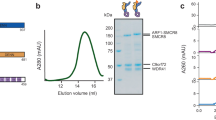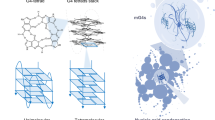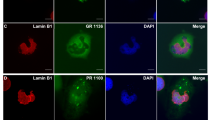Abstract
Mutation of C9orf72 is the most prevalent defect associated with amyotrophic lateral sclerosis and frontotemporal degeneration1. Together with hexanucleotide-repeat expansion2,3, haploinsufficiency of C9orf72 contributes to neuronal dysfunction4,5,6. Here we determine the structure of the C9orf72–SMCR8–WDR41 complex by cryo-electron microscopy. C9orf72 and SMCR8 both contain longin and DENN (differentially expressed in normal and neoplastic cells) domains7, and WDR41 is a β-propeller protein that binds to SMCR8 such that the whole structure resembles an eye slip hook. Contacts between WDR41 and the DENN domain of SMCR8 drive the lysosomal localization of the complex in conditions of amino acid starvation. The structure suggested that C9orf72–SMCR8 is a GTPase-activating protein (GAP), and we found that C9orf72–SMCR8–WDR41 acts as a GAP for the ARF family of small GTPases. These data shed light on the function of C9orf72 in normal physiology, and in amyotrophic lateral sclerosis and frontotemporal degeneration.
This is a preview of subscription content, access via your institution
Access options
Access Nature and 54 other Nature Portfolio journals
Get Nature+, our best-value online-access subscription
$29.99 / 30 days
cancel any time
Subscribe to this journal
Receive 51 print issues and online access
$199.00 per year
only $3.90 per issue
Buy this article
- Purchase on Springer Link
- Instant access to full article PDF
Prices may be subject to local taxes which are calculated during checkout




Similar content being viewed by others
Data availability
The electron microscopy density map has been deposited in the Electron Microscopy Data Bank with accession number EMD-21048. Atomic coordinates for C9orf72–SMCR8–WDR41 have been deposited in the PDB with accession number 6V4U. Source data are provided with this paper.
References
Majounie, E. et al. Frequency of the C9orf72 hexanucleotide repeat expansion in patients with amyotrophic lateral sclerosis and frontotemporal dementia: a cross-sectional study. Lancet Neurol. 11, 323–330 (2012).
DeJesus-Hernandez, M. et al. Expanded GGGGCC hexanucleotide repeat in noncoding region of C9ORF72 causes chromosome 9p-linked FTD and ALS. Neuron 72, 245–256 (2011).
Renton, A. E. et al. A hexanucleotide repeat expansion in C9ORF72 is the cause of chromosome 9p21-linked ALS-FTD. Neuron 72, 257–268 (2011).
O’Rourke, J. G. et al. C9orf72 is required for proper macrophage and microglial function in mice. Science 351, 1324–1329 (2016).
Sivadasan, R. et al. C9ORF72 interaction with cofilin modulates actin dynamics in motor neurons. Nat. Neurosci. 19, 1610–1618 (2016).
Shi, Y. et al. Haploinsufficiency leads to neurodegeneration in C9ORF72 ALS/FTD human induced motor neurons. Nat. Med. 24, 313–325 (2018).
Zhang, D., Iyer, L. M., He, F. & Aravind, L. Discovery of novel DENN proteins: implications for the evolution of eukaryotic intracellular membrane structures and human disease. Front. Genet. 3, 283 (2012).
Sellier, C. et al. Loss of C9ORF72 impairs autophagy and synergizes with polyQ Ataxin-2 to induce motor neuron dysfunction and cell death. EMBO J. 35, 1276–1297 (2016).
Sullivan, P. M. et al. The ALS/FTLD associated protein C9orf72 associates with SMCR8 and WDR41 to regulate the autophagy-lysosome pathway. Acta Neuropathol. Commun. 4, 51 (2016).
Amick, J., Roczniak-Ferguson, A. & Ferguson, S. M. C9orf72 binds SMCR8, localizes to lysosomes, and regulates mTORC1 signaling. Mol. Biol. Cell 27, 3040–3051 (2016).
Ugolino, J. et al. Loss of C9orf72 enhances autophagic activity via deregulated mTOR and TFEB signaling. PLoS Genet. 12, e1006443 (2016).
Yang, M. et al. A C9ORF72/SMCR8-containing complex regulates ULK1 and plays a dual role in autophagy. Sci. Adv. 2, e1601167 (2016).
Jung, J. et al. Multiplex image-based autophagy RNAi screening identifies SMCR8 as ULK1 kinase activity and gene expression regulator. eLife 6, e23063 (2017).
Amick, J., Tharkeshwar, A. K., Amaya, C. & Ferguson, S. M. WDR41 supports lysosomal response to changes in amino acid availability. Mol. Biol. Cell 29, 2213–2227 (2018).
Amick, J., Tharkeshwar, A. K., Talaia, G. & Ferguson, S. M. PQLC2 recruits the C9orf72 complex to lysosomes in response to cationic amino acid starvation. J. Cell Biol. 219, e20190676 (2020).
Farg, M. A. et al. C9ORF72, implicated in amytrophic lateral sclerosis and frontotemporal dementia, regulates endosomal trafficking. Hum. Mol. Genet. 23, 3579–3595 (2014).
Webster, C. P. et al. The C9orf72 protein interacts with Rab1a and the ULK1 complex to regulate initiation of autophagy. EMBO J. 35, 1656–1676 (2016).
Lan, Y., Sullivan, P. M. & Hu, F. SMCR8 negatively regulates AKT and MTORC1 signaling to modulate lysosome biogenesis and tissue homeostasis. Autophagy 15, 871–885 (2019).
Shen, K. et al. Architecture of the human GATOR1 and GATOR1–Rag GTPases complexes. Nature 556, 64–69 (2018).
Lawrence, R. E. et al. Structural mechanism of a Rag GTPase activation checkpoint by the lysosomal folliculin complex. Science 366, 971–977 (2019).
Shen, K. et al. Cryo-EM structure of the human FLCN–FNIP2–Rag–Ragulator complex. Cell 179, 1319–1329 (2019).
Bar-Peled, L. et al. A tumor suppressor complex with GAP activity for the Rag GTPases that signal amino acid sufficiency to mTORC1. Science 340, 1100–1106 (2013).
Tsun, Z. Y. et al. The folliculin tumor suppressor is a GAP for the RagC/D GTPases that signal amino acid levels to mTORC1. Mol. Cell 52, 495–505 (2013).
Shen, K., Valenstein, M. L., Gu, X. & Sabatini, D. M. Arg78 of Nprl2 catalyzes GATOR1-stimulated GTP hydrolysis by the Rag GTPases. J. Biol. Chem. 294, 2970–2975 (2019).
Sztul, E. et al. ARF GTPases and their GEFs and GAPs: concepts and challenges. Mol. Biol. Cell 30, 1249–1271 (2019).
Iyer, S., Subramanian, V. & Acharya, K. R. C9orf72, a protein associated with amyotrophic lateral sclerosis (ALS) is a guanine nucleotide exchange factor. PeerJ 6, e5815 (2018).
Wu, X. et al. Insights regarding guanine nucleotide exchange from the structure of a DENN-domain protein complexed with its Rab GTPase substrate. Proc. Natl Acad. Sci. USA 108, 18672–18677 (2011).
Corrionero, A. & Horvitz, H. R. A C9orf72 ALS/FTD ortholog acts in endolysosomal degradation and lysosomal homeostasis. Curr. Biol. 28, 1522–1535 (2018).
Jewell, J. L. et al. Differential regulation of mTORC1 by leucine and glutamine. Science 347, 194–198 (2015).
Nixon, R. A. The role of autophagy in neurodegenerative disease. Nat. Med. 19, 983–997 (2013).
Tang, D. et al. Cryo-EM structure of C9ORF72–SMCR8–WDR41 reveals the role as a GAP for Rab8a and Rab11a. Proc. Natl Acad. Sci. USA 117, 9876–9883 (2020).
Biyani, N. et al. Focus: the interface between data collection and data processing in cryo-EM. J. Struct. Biol. 198, 124–133 (2017).
Zheng, S. Q. et al. MotionCor2: anisotropic correction of beam-induced motion for improved cryo-electron microscopy. Nat. Methods 14, 331–332 (2017).
Zhang, K. Gctf: real-time CTF determination and correction. J. Struct. Biol. 193, 1–12 (2016).
Zivanov, J. et al. New tools for automated high-resolution cryo-EM structure determination in RELION-3. eLife 7, e42166 (2018).
Punjani, A., Rubinstein, J. L., Fleet, D. J. & Brubaker, M. A. cryoSPARC: algorithms for rapid unsupervised cryo-EM structure determination. Nat. Methods 14, 290–296 (2017).
Zhang, Y. I-TASSER server for protein 3D structure prediction. BMC Bioinformatics 9, 40 (2008).
Webb, B. & Sali, A. Protein structure modeling with MODELLER. Methods Mol. Biol. 1137, 1–15 (2014).
Peng, J. & Xu, J. RaptorX: exploiting structure information for protein alignment by statistical inference. Proteins 79 (Suppl 10), 161–171 (2011).
Kelley, L. A., Mezulis, S., Yates, C. M., Wass, M. N. & Sternberg, M. J. The Phyre2 web portal for protein modeling, prediction and analysis. Nat. Protocols 10, 845–858 (2015).
McGuffin, L. J., Bryson, K. & Jones, D. T. The PSIPRED protein structure prediction server. Bioinformatics 16, 404–405 (2000).
Pettersen, E. F. et al. UCSF Chimera—a visualization system for exploratory research and analysis. J. Comput. Chem. 25, 1605–1612 (2004).
Emsley, P. & Cowtan, K. Coot: model-building tools for molecular graphics. Acta Crystallogr. D 60, 2126–2132 (2004).
Afonine, P. V. et al. Real-space refinement in PHENIX for cryo-EM and crystallography. Acta Crystallogr. D 74, 531–544 (2018).
Adams, P. D. et al. PHENIX: a comprehensive Python-based system for macromolecular structure solution. Acta Crystallogr. D 66, 213–221 (2010).
Chen, V. B. et al. MolProbity: all-atom structure validation for macromolecular crystallography. Acta Crystallogr. D 66, 12–21 (2010).
Acknowledgements
We thank D. Toso, K. L. Morris, V. Kasinath and P. Tobias for cryo-EM advice and support; X. Shi for HDX support; C. Behrends and G. Stjepanovic for suggestions and contributions to the early stages of the project; R. Lawrence and M. Lehmer for cell imaging advice; and X. Ren for assistance with cloning. This work was supported by NIH grants R01GM111730 (J.H.H.) and R01GM130995 (R.Z.), Department of Defense Peer Reviewed Medical Research Program Discovery Award W81XWH2010086 (J.H.H.), the Bakar Fellows program (J.H.H.), the Pew-Stewart Scholarship for Cancer Research and Damon Runyon-Rachleff Innovation Award (R.Z.), a postdoctoral fellowship from the Association for Frontotemporal Degeneration (M.-Y.S.) and an EMBO Long-Term Fellowship (S.A.F.).
Author information
Authors and Affiliations
Contributions
M.-Y.S. designed and carried out all experiments, except for GEF assays and lysosome colocalization experiments, and performed all data analysis. S.A.F. performed GEF assays. R.Z. carried out lysosome colocalization experiments. M.-Y.S. and J.H.H. conceptualized the project and wrote the first draft. All authors contributed to the editing of the manuscript.
Corresponding author
Ethics declarations
Competing interests
J.H.H. is a scientific founder and receives research funding from Casma Therapeutics. R.Z. is a co-founder and stockholder in Frontier Medicines Corp.
Additional information
Peer review information Nature thanks Aaron Burberry, Sjors Scheres and the other, anonymous, reviewer(s) for their contribution to the peer review of this work.
Publisher’s note Springer Nature remains neutral with regard to jurisdictional claims in published maps and institutional affiliations.
Extended data figures and tables
Extended Data Fig. 1 Purification of the C9orf72–SMCR8–WDR41 and C9orf72–SMCR8 complex, as well as the HDX data for the trimer.
a, The Superose-6 gel filtration elution profile for the C9orf72–SMCR8–WDR41 complex. b, The Superose-6 gel filtration elution profile for the C9orf72–SMCR8 complex. mAU, milli-absorbance units. c, The purified full-length C9orf72–SMCR8–WDR41 and C9orf72–SMCR8 complexes were analysed by SDS–PAGE. The proteins were purified at least five times with similar results (a–c). d–f, Deuterium uptake data for the C9orf72–SMCR8–WDR41 complex at the 0.5-s time point, with error bars from triplicate technical measurements. Peptides with more than 50% deuterium uptake are the flexible regions. Y axis represents the average per cent deuteration. X axis demonstrates the midpoint of a single peptic peptide.
Extended Data Fig. 2 Cryo-EM data processing.
a, A representative cryo-EM micrograph of the C9orf72–SMCR8–WDR41 complex. b, Representative 2D classes. c, Orientation distribution of the aligned C9orf72–SMCR8–WDR41 particles. d, Image processing procedure.
Extended Data Fig. 3 Resolution estimation of the cryo-EM map, as well as model building and validation.
a, Comparison between FSC curves. b, Refined coordinate model fit of the indicated region in the cryo-EM density. c, Refinement and map-versus-model FSC. d, Cross-validation of test FSC curves to assess overfitting. The refinement target resolution (4.2 Å) is indicated. e. Different views of the final reconstruction.
Extended Data Fig. 4 Deuterium uptake of C9orf72–SMCR8–WDR41.
HDX-MS data are shown in heat map format, in which peptides are represented by rectangular strips above the protein sequence. Absolute deuterium uptake after 0.5, 5, 50, 500 and 50,000 s are indicated by a colour gradient below the protein sequence.
Extended Data Fig. 5 Deuterium uptake of C9orf72–SMCR8 complex.
HDX-MS data are shown in heat map format, in which peptides are represented by rectangular strips above the protein sequence. Absolute deuterium uptake after 0.5, 5, 50, 500 and 50,000 s are indicated by a colour gradient below the protein sequence.
Extended Data Fig. 6 Mapping the protected region from HDX results onto the SMCR8–C9orf72–WDR41 structure.
a, The HDX uptake difference at 0.5 s was mapped on C9orf72–SMCR8. b–d, Close-up view of M1 (b) and M2–M5 (c) regions of SMCR8, and the M1 region of C9orf72 (d). e, Enlarged view of the WDR41 residues in the SMCR8–WDR41 interface.
Extended Data Fig. 7 Co-expression and pulldown validation of C9orf72–SMCR8 and SMCR8–WDR41 interface.
a, Close-up view of the residues that mediate the DENN– DENN dimerization between C9orf72 and SMCR8. b, Co-expression and pulldown experiment of Strep-tagged SMCR8 with GST–C9orf72 mutants and WDR41. c, Pulldown experiment of GST–WDR41 mutants with C9orf72–SMCR8. The pulldown experiments were carried out at least twice with similar results (b, c).
Extended Data Fig. 8 Structural comparison between C9orf72–SMCR8 and FNIP2–FLCN.
Left, structural alignment of full-length FNIP2–FLCN and C9orf72–SMCR8. Right, comparison between the longin dimers (top), DENN dimers (middle) and SMCR8 DENN with C9orf72 DENN domain (bottom).
Extended Data Fig. 9 GTPase assay for different small GTPases with C9orf72–SMCR8–WDR41.
a, SDS–PAGE of GAP protein complex (top) and GTPase proteins (bottom) used in the experiments. b, Tryptophan fluorescence GTPase signal was measured for purified RAGA–RAGC, ARL8A, ARL8B, RAB1A and RAB7A before and after addition of C9orf72–SMCR8–WDR41. The fluorescence signal upon GAP addition was normalized to 1 for each experiment. The experiments were carried out in triplicate and one representative plot is plotted. c, Tryptophan fluorescence GTPase signal was measured for purified ARF6, ARF(Q67L) or ARF5, before and after addition of C9orf72–SMCR8–WDR41, C9orf72–SMCR8(R147A)–WDR41 or C9orf72–SMCR8. d, HPLC-based GTPase assay with ARF6, ARF5, RAB1A, RAB7A, ARL8A, ARL8B and RAGA–RAGC proteins in the absence and addition of C9orf72–SMCR8–WDR41 complex, as indicated. The experiments were carried out in triplicate and one representative plot is shown. All experiments were carried out at least three times independently with similar results (a–d).
Extended Data Fig. 10 HPLC-based GTPase assay with ARF1 or ARF1(Q71L) proteins.
Assays were performed in the absence and addition of GAP complex, as indicated. The experiments were carried out in triplicate and one representative plot is shown. All experiments were carried out at least three times independently with similar results.
Extended Data Fig. 11 GEF assay for different small GTPases with C9orf72–SMCR8–WDR41.
a, SDS–PAGE of C9orf72–SMCR8–WDR41 complex and GTPase proteins used in the experiments. b, GEF assay with mantGDP-reloaded RAB1A, RAB5A, RAB7A, RAB8A and RAB39B proteins in the absence and addition of C9orf72–SMCR8–WDR41 complex, as indicated. RAB5A treated with RABEX5 was used as a positive-control reaction. Data were baseline-subtracted and normalized to the signal immediately after GTP addition, which also is the 0-s time point in the plots. Plots are mean ± s.d. of each technical triplicate experiment. All experiments were carried out at least twice independently with similar results (a, b). c, Structural alignment of C9orf72–SMCR8–WDR41 with DENND1B–RAB35 (PDB 3TW8).
Supplementary information
Supplementary Information
This file contains Supplementary Fig.1 presenting the uncropped gels for Fig. 2 and Extended Data Figs. 1, 7, 9, and 11.
Supplementary Data
This file contains Supplementary Dataset 1 presenting the HDX data summary.
Rights and permissions
About this article
Cite this article
Su, MY., Fromm, S.A., Zoncu, R. et al. Structure of the C9orf72 ARF GAP complex that is haploinsufficient in ALS and FTD. Nature 585, 251–255 (2020). https://doi.org/10.1038/s41586-020-2633-x
Received:
Accepted:
Published:
Issue Date:
DOI: https://doi.org/10.1038/s41586-020-2633-x
This article is cited by
-
Lysosomes as coordinators of cellular catabolism, metabolic signalling and organ physiology
Nature Reviews Molecular Cell Biology (2024)
-
Pathological insights from amyotrophic lateral sclerosis animal models: comparisons, limitations, and challenges
Translational Neurodegeneration (2023)
-
C9orf72 functions in the nucleus to regulate DNA damage repair
Cell Death & Differentiation (2023)
-
An interaction between synapsin and C9orf72 regulates excitatory synapses and is impaired in ALS/FTD
Acta Neuropathologica (2022)
-
Autophagy Dysfunction in ALS: from Transport to Protein Degradation
Journal of Molecular Neuroscience (2022)
Comments
By submitting a comment you agree to abide by our Terms and Community Guidelines. If you find something abusive or that does not comply with our terms or guidelines please flag it as inappropriate.



